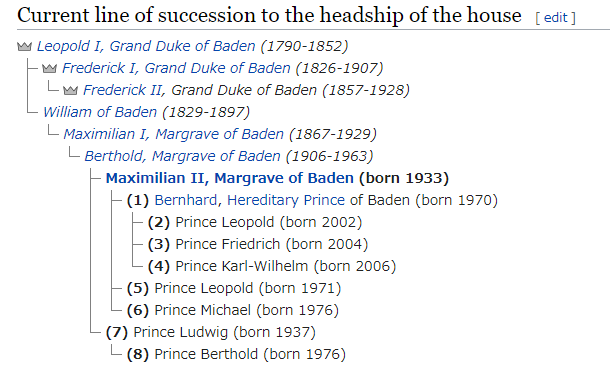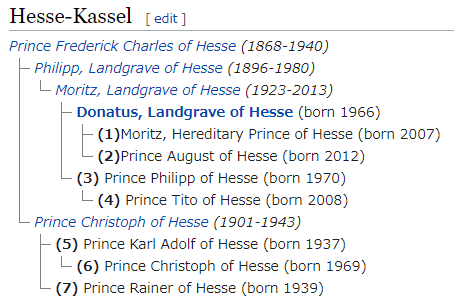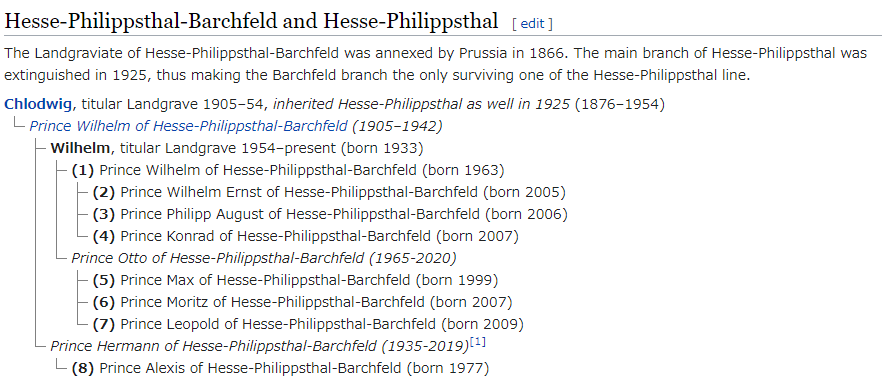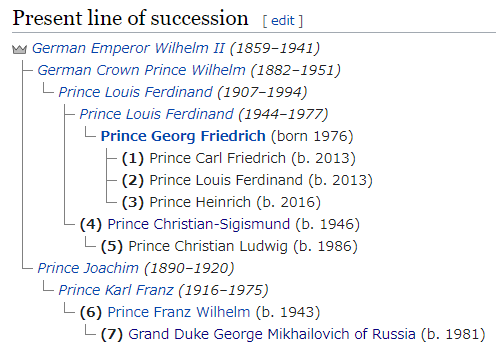In Wikipedia, this article’s name is(was) Line of succession to the former Mecklenburg thrones.
note:
As of August 2020.
The line of succession to the Mecklenburg thrones was an ordered list of people eligible to succeed to the grand ducal thrones of Mecklenburg-Schwerin and Mecklenburg-Strelitz. The monarchies in both these states were abolished in 1918 following the outbreak of the November Revolution in the German Empire. Today only the House of Mecklenburg-Strelitz survives.
Succession
The Grand Duchies law of succession stated that only males could succeed to the total exclusion of females and so this remains the succession law used by the House today.[1] As a result, the House of Mecklenburg-Schwerin became extinct in 2001 on the death of the last male of the House, Friedrich Franz, Hereditary Grand Duke of Mecklenburg-Schwerin, leaving the House of Mecklenburg-Strelitz the only surviving line of the House of Mecklenburg.[2]
The House of Mecklenburg-Strelitz itself was on the brink of extinction until 1928 when the only male and head of the House, Charles Michael, Duke of Mecklenburg, adopted and recognised his morganatic nephew, Count George of Carlow, as his heir. The last Grand Duke from the Strelitz line, Adolphus Frederick VI, committed suicide on 23 February 1918 and as his cousin and heir Charles Michel was a national of Russia and so not in Mecklenburg, Frederick Francis IV, Grand Duke of Mecklenburg, established a regency in Strelitz until the establishment of a Free State.
Count George was recognised as a Duke of Mecklenburg (Serene Highness) on 18 July 1929 by the head of the Imperial House of Russia, Grand Duke Cyril Vladimirovich, and then five months later on 29 December by Frederick Francis IV. On 18 December 1950 it was announced the style of Highness was recognised for him and the rest of the Mecklenburg-Strelitz family.[3] His position as head of the House of Mecklenburg-Strelitz was also confirmed.[4]
Lines of succession in November 1918
Mecklenburg-Schwerin
- HRH Grand Duke Frederick Francis II (1823–1883)
- HRH Grand Duke Frederick Francis III (1851–1897)
- HRH Grand Duke Frederick Francis IV (b. 1882)[5]
- (1) HRH Hereditary Grand Duke Frederick Francis (b. 1910)[5]
- (2) HH Duke Christian Louis (b. 1912)[5]
- HRH Grand Duke Frederick Francis IV (b. 1882)[5]
- (3) HH Duke John Albert (b. 1857)[5]
- (4) HH Duke Adolphus Frederick (b. 1873)[5]
- (5) HRH Duke Henry, Prince of the Netherlands (b. 1876)[5]
- (6) HH Duke Paul Frederick (b. 1852)[5]
- (7) HH Duke Henry Borwin (b. 1885)[5]
- HRH Grand Duke Frederick Francis III (1851–1897)
Note: On 21 April 1884 Duke Paul Frederick deferred his and his sons rights of succession in favour of his younger brothers and their sons, enabling them to take precedence over him and his.[6][7]
Mecklenburg-Strelitz
- HRH Grand Duke George (1779–1860)
- HRH Grand Duke Frederick William (1819–1904)
- HRH Grand Duke Adolphus Frederick V (1848–1914)
- HRH Grand Duke Adolphus Frederick VI (1882–1918)
- HRH Grand Duke Adolphus Frederick V (1848–1914)
- HH Duke George August (1824–1876)
- HH Duke Georg Alexander (1859–1909)
- Count George of Carlow (b. 1899)
- (1) HH Duke Charles Michael (b. 1863)[5]
- HH Duke Georg Alexander (1859–1909)
- HRH Grand Duke Frederick William (1819–1904)
Note: The throne became vacant on 23 February 1918 following the death of Grand Duke Adolphus Frederick VI. The heir to the throne Duke Charles Michael was in Russia at the time.
Current House of Mecklenburg-Strelitz line of succession
- HH George, Duke of Mecklenburg (1899-1963)
- HH George Alexander, Duke of Mecklenburg (1921-1996)
- Borwin, Duke of Mecklenburg (born 1956)
- (1) HH Duke Alexander (b. 1991)[2]
- (2) HH Duke Michael (b. 1994)[2]
- Borwin, Duke of Mecklenburg (born 1956)
- HH George Alexander, Duke of Mecklenburg (1921-1996)




